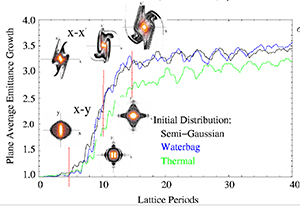
Joined the laboratory in 2014
- BS, Physics Auburn University, 1987
- PhD, Physics Massachusetts Institute of Technology, 1992
- Accelerator physics
Research
Charged particle accelerators have long been the driving engine of discovery in fundamental areas of physics such as high-energy physics, nuclear physics, and astrophysics, as well as vital tools to probe material properties in a wide variety of manners in applied physics via accelerator-driven light sources, spallation neutron sources, and microscopes. Accelerators also play a key role in applications such as materials processing, medical diagnostics and therapies, and potential advanced energy sources. This central role in science and technology has driven the field for many years, and accelerator physics itself is a vibrant discipline of physics. Machines represent a tour de force on the creative use of physics and technology to produce a plethora of machines based on different concepts and architectures for generating a broad range of beams for diverse applications. The field produces a rich range of applied physics problems providing opportunities for researchers and students to extend advances.
My field is theoretical accelerator physics emphasizing analytic theory and numerical modeling. Before arriving at MSU in 2014 to work at FRIB, I held a joint appointment at Lawrence Livermore and Berkeley national laboratories working on physics issues associated with the transport of beams with high charge intensity, design of accelerator and trap systems, large- and small-scale numerical simulations of accelerators, support of laboratory experiments, and design of electric and magnetic elements to focus and bend beams. A common theme in my research is to identify, understand, and control processes that can degrade the quality of the beam by increasing phase-space area or can drive particle losses. Typically, laboratory experiments and support simulations identify effects, which are then further analyzed with reduced simulations and analytic theory to understand and mitigate any deleterious consequences. Graduate-level teaching is used to clarify advances and place developments into context within the broader field.

How students can contribute as part of my research team
At FRIB, I am presently seeking physics students with interests in charged particle dynamics, electromagnetic theory, and numerical modeling to assist me in simulations and theory in support of FRIB now under construction at MSU. The FRIB linear accelerator will deliver exceptionally high-power beams to support nuclear physics via beams of rare isotopes produced post-target. This should be one of the premier accelerator facilities for nuclear physics and will provide a fertile training ground for the next generation of accelerator physicists to join this vibrant field with broad opportunities.
Scientific publications
- Envelope model for passive magnetic focusing of an intense proton or ion beam propogating through thin foils, S.M. Lund, R.H. Cohen, and P.A. Ni, Phys. Rev. ST – Accel. and Beams 16, 044202 (2013).
- Sheet beam model for intense space-charge: Application to Debye screening and the distribution of particle oscillation frequencies in a thermal equilibrium beam, S.M. Lund, A. Friedman, and G. Bazouin, Phys. Rev. ST – Accel. and Beams 14, 054201 (2011).
- Space-charge transport limits of ion beam in periodic quadrupole channels, S.M. Lund and S.R. Chawla, Nuc. Instr. Meth. A 561, 203-208 (2006).

